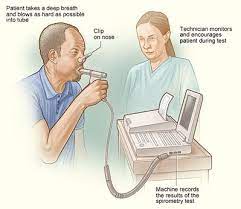A 75-year-old man with a history of hypertension and peptic ulcer disease presents with dyspnea on exertion to the emergency department (ED). He notes black-colored stools for the past 2 weeks. His initial examination is notable for conjunctival pallor, clear lung fields without rales, wheezing, or rhonchi, as well as tachycardia with a regular rhythm, normal s1 and s2, and without murmurs, rubs, or gallops. Initial laboratory workup reveals a hemoglobin of 5.5 g/dL, reduced from a baseline of 12 g/dL on routine outpatient laboratory testing from 3 months prior. His basic metabolic panel, arterial blood gas (ABG), and lactateare all within normal limits. A chest radiograph (CXR) is normal.
What is the mechanism of this man’s dyspnea on exertion?
A. Decreased cardiac output
B. Decreased oxygen delivery
C. Decreased systemic vascular resistance
D. High-output heart failure
E. Pulmonary edema
Answer:

